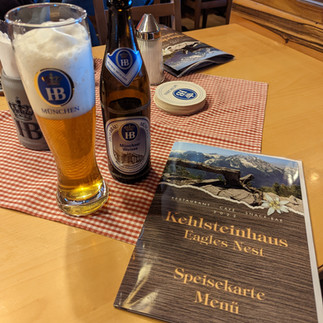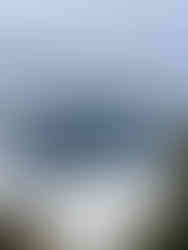The Tailor-Made Guide to Visiting The Eagle's Nest and Berchtesgaden
- Barry Pickard
- Feb 23
- 10 min read

Author: Barry Pickard
Hi, I'm Barry, the owner of Tailor-Made Itineraries and I have been designing bespoke self-guided tours for adventurous and curious travellers since 2015. I am a history graduate with a passion for travel.
I created this blog to show, through my own adventures, how you can have an incredible travel experience as an independent traveller, giving you the information to navigate the world with confidence.
Contents
What was The Eagle's Nest used for during World War II? What is the best way to get to The Eagle's Nest? What can I see and do at The Eagle's Nest? Mannlsteig Berchtesgaden
Have you ever wondered, What’s the best way to visit the Eagle’s Nest and Berchtesgaden? If so, you’re in the right place.
Picture this: crisp mountain air filling your lungs, the scent of damp pine and cool stone all around you. The only sounds are the distant clang of cowbells and the occasional murmur of fellow travellers, their voices swallowed by the sheer vastness of the Bavarian Alps. Then, as you step out onto the terrace of the Eagle’s Nest, it hits you—this view is like nothing else. Rolling green valleys stretch far below, while jagged peaks stand like sentinels in the distance. It’s breathtaking, not just for its beauty, but for its history.

I’ve been lucky enough to visit Berchtesgaden and the Eagle’s Nest more than once, and each time, I’ve learned something new—about the best routes, the hidden costs, and the little details that can make or break your trip. This isn’t just another list of generic travel tips. This is everything I wish I’d known before I went, based on my own experiences, written for independent travellers like you.
So, if you're planning your own trip and want to avoid the common mistakes while making the most of your time, stick with me. I’ll walk you through exactly how to do it right. Let’s get started.

Don’t forget that Tailor-Made Itineraries delights in creating bespoke self-guided tours. So, if visiting The Eagle's Nest and Berchtesgaden appeals to you, reach out to me by email. I would be more than happy to design a self-guided tour around your requirements incorporating these Bavarian delights or indeed, a general tour of Germany.

Guide to Visiting The Eagle's Nest and Berchtesgaden
The Eagle's Nest (or Kehlsteinhaus as it is known in German) is a chalet-type building that was built near the summit of the Kehlstein mountain in the Bavarian Alps, near the town of Berchtesgaden. The building was commissioned for Adolf Hitler as a summer retreat and was used for official and social gatherings by the Nazi Party during World War II.

The Eagle's Nest is located at an altitude of 1,834 meters (6,017 feet). The only way to reach the building is by taking a tunnel to a special elevator that was built into the mountainside. The elevator ride takes about 40 seconds to ascend the 124 meters (407 feet) to the Eagle's Nest (note: photography is not allowed in the elevator).
The Eagle's Nest is a relatively small building, with a footprint of only about 200 square meters (2,153 square feet). The building is made of stone and timber and has a chalet-style design. The interior of the building is decorated in a simple, rustic style.
If you are enjoying this Guide to Visiting The Eagle's Nest and Berchtesgaden, remember and subscribe to my mailing list to receive my latest blog posts.
What was The Eagle's Nest used for during World War II?
The Eagle's Nest was completed in 1938, but it is a fallacy that it was given to Hitler as a gift for his 50th birthday. Hitler visited the Eagle's Nest on a number of occasions, but he never stayed there for more than a few days at a time. The building was also used for official and social gatherings by the Nazi Party.
In 1945, the Eagle's Nest was captured by the Allied forces. The building was originally intended to be destroyed, but it was eventually spared because of its historical significance.
If you are interested in visiting the other locations related to the rise of Hitler and the Nazi Party, check out our previous blog post on Munich: The Tailor-Made Top 21 Attractions to Visit in Munich, Part 1
What is the best way to get to The Eagle's Nest?
Today, the Eagle's Nest is a popular tourist destination. The building is open to the public and can be visited by taking a special bus. Visitors need to purchase a joint ticket for the Eagle’s Nest and the bus. The ticket can be purchased online or at the bus station ticket kiosk at the foot of mountain, near Obersalzburg. There is ample car parking beside the bus station. The bus will drop you off at the tunnel which leads to the elevator, and you should get the return bus from here too. Please note that the road route up to the elevator is only accessible to the buses. Cars need to be parked beside the bus station. The Eagle's Nest can be very crowded, so it is best to visit early in the morning or late in the afternoon.
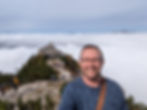
What can I see and do at The Eagle's Nest?
The Eagle’s Nest building is now primarily a restaurant, with ample seating both inside and out. The menu is focused on German cuisine, and you can have a beer with your meal too. I can testify to the fact that their food is really good and value for money.
There is a set of display boards showing the history of the Eagle’s Nest, but the star of the show is obviously the views. Even though it was cloudy during my visit, with the Eagle’s Nest towering above the cloud level, I still received amazing views in between the overcast skies.
If you are enjoying this Guide to Visiting The Eagle's Nest and Berchtesgaden, remember and subscribe to my mailing list to receive my latest blog posts.

Mannlsteig
The hiking trail that leads upward from the Eagle’s Nest is called the Mannlsteig. The trail is a challenging one, with a steep ascent and a number of exposed sections. However, the views from the summit are well worth the effort and you also get a great peek into Austria. I only hiked along the trail for around twenty minutes before heading back, but this was more than enough time to enjoy spectacular views.
The trail eventually reaches the Mannlstieg ridge, a narrow ridge with stunning views of the surrounding mountains. The trail then continues along the ridge to the summit of the Kehlstein. The Mannlsteig trail is a popular hiking trail, but it is important to be prepared for the challenging conditions. The trail is steep and there are a number of exposed sections. It is also important to be aware of the weather conditions, as the trail can be dangerous in bad weather.
Read on the find out about the town of Berchtesgaden.
Berchtesgaden
The history of Berchtesgaden dates back to the 11th century, when it was founded as a monastery. The town remained under the control of the monastery until the early 19th century, when it became part of Bavaria and it wasn't until this time that Berchtesgaden became a popular tourist destination, thanks to its beautiful scenery, its historical sites, and its outdoor activities.
If you are enjoying this Guide to Visiting The Eagle's Nest and Berchtesgaden, remember and subscribe to my mailing list to receive my latest blog posts.
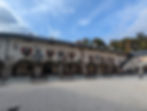
Renewed focus on the town occurred during the 1930s, especially when construction began on the Eagle's Nest. Berchtesgaden then became a popular destination for Nazi Party leaders and other high-ranking officials. The town was also home to a number of Nazi Party buildings and facilities.
If you are interested in visiting the other locations related to the rise of Hitler and the Nazi Party, check out our previous blog post on Nuremberg: The Tailor-Made Top 11 Attractions to Visit in Nuremberg
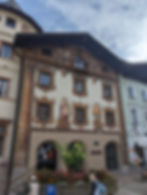
After the war, Berchtesgaden became a popular tourist destination again and today there are a number of interesting attractions to visit, and you could easily spend a long weekend here, especially if you like outdoor pursuits like hiking. Highlights of the town centre are Schloss Berchtesgaden, and the churches of Stiftskirche St. Peter und Johannes der Täufer, and of St. Andreas. The Museum Schloss Adelsheim is also a short walk from the centre.
Read on to find out about the Salzbergwerk and House of Mountains.
Tailor-Made Top Tip: Make sure to try the ice cream at Eiscafé La Fontana. Absolute bliss!
Salzbergwerk Berchtesgaden
Salzbergwerk Berchtesgaden is a salt mine that has been in operation for over 500 years. Located in the northern part of town, the salt mine was originally operated by the monks of the Berchtesgaden Abbey. By the 19th century, the salt mine was taken over by the Bavarian government.
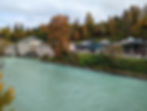
The Saltworks of Berchtesgaden is one of the deepest salt mines in the world. The mine is over 1,000 meters deep and has over 50 kilometers of tunnels. The salt mine is home to a variety of salt formations, including salt stalagmites, stalactites, and a lake.

Visitors to the Saltworks of Berchtesgaden can take a guided tour of the mine. The tour takes visitors through the mine's tunnels and chambers, and it provides information about the history of salt mining in the area. You receive your set of overalls at the visitor centre, then head into the mine on a mini railway line and it goes at a fair speed as well. So much fun!
After the rail journey, you start to walk through the tunnels, before getting to go down two separate wooden slides – a quick way for the miners to descend to their place of work (you can take the stairs if you don’t fancy the slides). You even get the chance to buy a photo of yourself going down the slide – was that a look of terror on my face?
The excitement doesn’t end there, because you then get the chance to board a ferry and cross a salty lake, deep underground, then to ascend back towards the surface, you hop in a funicular, before getting back on the miniature train. I’m not sure that there is anywhere else in the world where you can take a train ride, go down wooden slides, sail across a lake and take a funicular all in the same attraction.

The Saltworks of Berchtesgaden is a truly unique experience and a must do when visiting the area. It is a great family experience, although children under 4 years old are not allowed on the journey. Wear sturdy shoes and comfortable clothing and be mindful that the temperature in the mine is around 12 degrees Celsius (53 degrees Fahrenheit). There is a large carpark on the western side of the main road, with an underpass that leads to the Saltworks.
Tailor-Made Top Tip: There is an excellent gift shop where you can buy a myriad of salt-related gifts. My favourite was the gin that had been matured down in the mine, where the salty atmosphere gives the gin a unique taste.
If you are enjoying this Guide to Visiting The Eagle's Nest and Berchtesgaden, remember and subscribe to my mailing list to receive my latest blog posts.
House of Mountains
The House of Mountains (Nationalparkzentrum Haus der Berge) is an educational and visitor centre dedicated to the Berchtesgaden National Park, Germany's only Alpine national park. It was opened in 2013 and is housed in a modern, sustainable building. The centre features a variety of exhibits and activities that teach visitors about the park's unique geology, ecology, and cultural heritage.

One of the most popular exhibits at the House of Mountains is the "Vertical Wilderness" permanent exhibition. This exhibit takes visitors on a journey through the park's different ecosystems, from the valley floor to the mountain peaks. Visitors can learn about the plants and animals that live in each ecosystem, and they can also see interactive exhibits that demonstrate the park's natural processes.

In addition to the permanent exhibition, the House of Mountains also hosts a variety of temporary exhibitions and events throughout the year. These exhibitions often focus on specific aspects of the park's natural or cultural heritage.
The House of Mountains is a great place to learn about the Berchtesgaden National Park and to prepare for a visit to the park. The centre’s exhibits and activities are informative and engaging, and the staff is always happy to answer questions.

Related Blog Posts
If you would like more information on Bavaria and how to visit these locations, please view the Tailor-Made Itineraries posts below:
Conclusion
Berchtesgaden and The Eagle's Nest are a must-visit for any traveller looking to experience the unique blend of natural beauty, history, and culture that this region has to offer. From stunning mountain views to charming local villages, this region is truly a treasure trove of experiences waiting to be discovered. Whether you're seeking adventure, history, or simply a peaceful escape, Berchtesgaden and The Eagle's Nest have something for everyone. Don't miss the chance to add these incredible destinations to your travel itinerary!
Comment below and let us know if you have visited Berchtesgaden and The Eagle's Nest.
Don’t forget that Tailor-Made Itineraries delights in creating bespoke self-guided tours. So, if visiting The Eagle's Nest and Berchtesgaden appeals to you, reach out to me by email. I would be more than happy to design a self-guided tour around your requirements incorporating these Bavarian delights or indeed, a general tour of Germany.
Join me next time when I discover the fascinating locations connected to the Nazis V2 rocket programme. Tailor-Made Itineraries posts every two weeks, and you can subscribe to the latest blog and newsletter here. Until then, happy reading and safe travels.
Barry
Contact Me: tailoritineraries@gmail.com
Tailor-Made Itineraries creates one-of-a-kind bespoke self-guided travel itineraries for adventurous and curious travellers.
These self-guided tours deliver a personalised and exciting holiday experience that takes the effort out of trip planning.



























